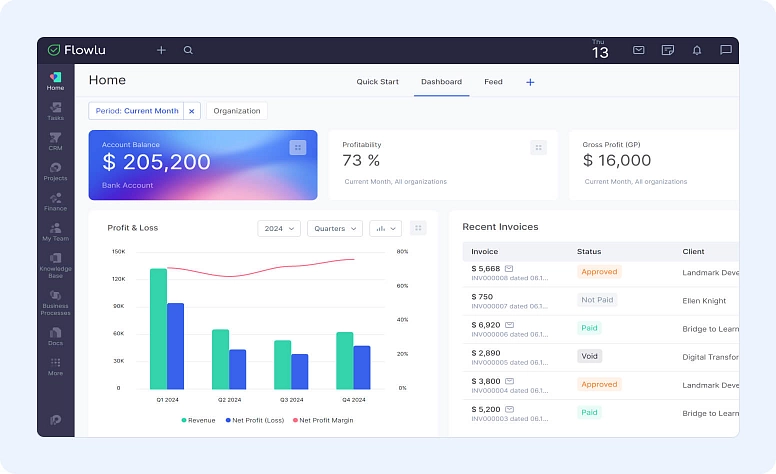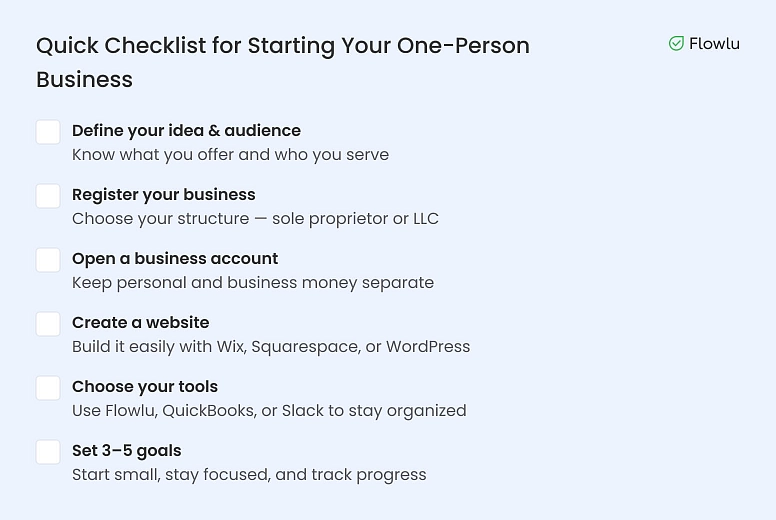How to Run a One-Person Business: Essential Tips for Solopreneurs
- What Is a One-Person Business?
- Why Run a One-Person Business? Benefits & Challenges
- Essential Skills for Solo Entrepreneurs
- 3 Steps for Starting a One-Person Business
- Two Negative Aspects of Running a One-Person Business
- Planning & Legal Setup for Solo Business
- Managing Finances as a Solopreneur
- How to Market Your One-Person Business
- How to Overcome Common Solopreneur Challenges
- Bottom Line
We all know that starting a business isn’t easy. And if you’re exploring ways to go into business for yourself, it may be even more difficult because you don’t have a team to help you. On the other hand, this is your chance to do what you have always wanted to do: starting a solo business that reflects your vision.
So, even though it may look a bit scary at the moment, take a deep breath and go step by step. Take one step at a time, and before you realize it, you’ll already be running a one-person business.
What Is a One-Person Business?
Today, over 80% of new small business launches in the U.S. are without employees. A one-person business is a venture that answers the question many aspiring entrepreneurs ask: how do I go into business for myself? You are the only person in charge of everything: from planning and selling to managing customers and finances. You don’t have employees, but you may work with freelancers or contractors when needed.
Many entrepreneurs start this kind of venture because it’s easier to begin small and grow later. The perks include that you can work from home, use your own schedule, and make all the decisions for your company.
Why Run a One-Person Business? Benefits & Challenges
Running a one-person business has many good things, but as you’ll find in many articles on owning your own company, it also has some difficulties you may face.
The main benefit is freedom. You can decide how to work, what to sell, and who your customers are. You don’t need to wait for anyone’s approval. Furthermore, you can also save money because you don’t pay salaries to employees. Also, a recent survey found that 77% of new solopreneurs became profitable in their first year, and 93% expect profitability in 2025.
However, it’s not always easy. You will need to do many tasks alone, e.g., marketing, customer support, and accounting. It can also feel lonely sometimes, and there’s more pressure because everything depends on you.
Still, if you plan well and stay organized, a solo project can be a great way to start your dream.
Essential Skills for Solo Entrepreneurs
According to a 2025 survey, 51% of solopreneurs believe their business will grow over the next year, and 74% say their business already provides a stable income — encouraging results for new entrepreneurs everywhere. To run a solo enterprise, you need a few key skills.
First, you should be good at organizing your time, schedule, and tasks. Since you work alone, no one will remind you what to do. Second, you require basic knowledge about sales, marketing, and accounting. You don’t need to be an expert, but you should understand how to attract customers and manage your money.
You also require communication skills to talk with clients and partners clearly. And finally, you require patience and motivation. Sometimes, things move slowly, but if you stay focused, you’ll grow your business step by step.
If you plan to manage your clients and tasks more easily, check our short guide on the best CRM tools for solopreneurs. It shows how to keep everything in one place.
3 Steps for Starting a One-Person Business
If you’re looking to know more about how to start a one-person business, look no further. Just take a look at the steps you need to follow:
Step #1: Start Your New Business on the Side
While becoming a small business owner may have always been the dream of your life, it’s worth being careful. The truth is that it will be a lot safer if you keep your current job for a while for two different reasons:
#1: It May Not Be for You: Trust me when I say this, because many people create a detailed plan for their new venture only to find out that the entrepreneur’s life is not for them. And it’s perfectly fine.
2: You Won’t Worry About Income: One of the main reasons why so many solo businesses fail is because you need to worry about income. You need to eat and have a place to sleep. And this can all be avoided if you maintain your current job. As soon as you’re already making a decent and steady income, then you may think about quitting and dedicating your time entirely to your new project.
Not ready to quit your job yet? You can start small by freelancing. Read our simple guide for beginners to learn how to get your first clients.
Step #2: The Business Structure
Determining the right business structure for you is very important. And obviously, the most common option is a sole proprietorship. Even though this is the simplest structure, it has both advantages and disadvantages.
The main advantage of this legal structure is that it is flexible. This means that you may be a freelancer working from home, run a more traditional small business, or become an independent contractor.
As for the main disadvantage, it’s the fact that it comes with many risks, since you’ll be the only person responsible for both profits and debts. And while profits should be fine, in the case of debt, you may need to deal with a lawsuit that puts your assets on the line.
To prevent this from happening, some experts recommend opening a limited liability company (LLC) instead to protect your interests.
Step #3: Your Business Structure May Change
No matter if you choose a sole proprietorship or an LLC to start your company, you can always change it in the future. You probably have the idea of growing your business to the point where you’ll need to hire people to help you. At that moment, your legal entity may need to change.
Two Negative Aspects of Running a One-Person Business
We’re not here to tell you that everything will be easy and run smoothly. Nothing in life works like this. So, we believe that you need to evaluate both the pros and cons of going solo. And there are two main cons of running a one-person business:
#1: The Revenue:
It’s normal that you imagine your project will be an immediate success and that you’ll start making a lot of money right from the start. The sad truth is that this will hardly ever happen, especially at the beginning. Just to give you an idea, most solopreneurs make less than $50,000 per year.
#2: Growth:
Just like with revenue, you may be wondering if your venture will grow rapidly. And it may happen, but it is unlikely. Just think of the most successful businesses you know. Now, do you have an idea about how many employees these companies have? Most probably, thousands of people. So, you just can’t expect to create a company on your own that will become a multimillion-dollar one in no time. Before this happens, you’ll need to hire a lot of people to work with you.
Planning & Legal Setup for Solo Business
If you’re looking to learn how to set up a personal business, here’s what you need to do:
#1: Create a Business Plan:
The first thing you need to do is grab a piece of paper and write down all the ideas you have for your new company. Make sure that you come up with a strategy and also take the time to identify your target audience. Don’t forget to describe what makes your business different from all the others in the industry.
#2: Check with a Business Adviser:
Even though you’re going solo, it doesn’t mean that you shouldn’t take some precautions or extra steps. A business adviser can show you the best way to start your business.
#3: Do a Quick Search for Business Credit Cards and Bank Accounts:
As a business, you’ll need to have both a bank account and a credit card in the name of your company. While you could keep your personal and business records together, it is wiser to maintain them separately right from the start. For example, you may need to ask for a loan in the future, and it’ll be easier this way.
#4: Hire People:
There will come a point when you’ll need to start hiring people to help you out. No matter if you need them to handle social media, shipping, or even to help you with customer support, this is a very positive sign. So, don’t delay the decision and delegate some of your tasks.
#5: Patience Is a Virtue:
Your goal is to manage a successful company. And it will be if you allow it to grow. You need to always keep in mind that a solo business takes longer to grow than an endeavor that has multiple people working there.
Managing Finances as a Solopreneur
Money is one of the most important things in any business. When you work alone, you must be even more careful. You are the only person responsible for how much you earn and spend.
Start by separating your personal and business money. Have a bank account and card only for your project. This will help you see your real profits and expenses better.
You should also write down all your income and expenses every month. It doesn’t matter if you use a notebook or an online tool: the important thing is to keep records. Many solopreneurs forget this and then have problems when it’s time to pay taxes or ask for a loan.
To help you stay organized, you can use accounting tools like QuickBooks, Wave, or FreshBooks. They make it easy to send invoices, track expenses, and plan for taxes. If you prefer an all-in-one system that also manages your projects and clients, you can try Flowlu or Honeybook.
Another smart idea is to save part of your income for taxes and unexpected costs. Even if your company is small now, you will need some extra money one day for marketing, new tools, or slow months. A simple app like YNAB (You Need a Budget) or PocketGuard can help you manage savings goals.
Pricing & Income Tips for Solopreneurs
When you work alone, your income depends completely on how you price your products or services. Before you start selling, take a look at what others in your area or industry charge. Think about your time, tools, and effort, then set a price that covers your costs and still gives you profit.
It’s also smart to offer different options — for example, basic and premium packages — so clients can choose what fits their budget. Review your prices every few months and adjust them if your skills or demand grow.
Want more stable income? Learn how to use retainer agreements to keep long-term clients and get regular payments.
How to Market Your One-Person Business
Now that your business is ready, it’s time to tell people about it. Marketing is not only for big companies. Even a solo venture needs to show what it offers and reach the right customers.
Create a website or a social media page where people can learn more about your products or services and explore your content. You can build your website with Wix, WordPress, or Squarespace. Add clear information, a contact form, and some pictures or examples of your work.
If you’re just starting and need your first clients, check out these top freelance websites
You can also write short posts or articles and other content about your area. This will help people find you online. For example, if you offer design services, share tips about colors or logos. Step by step, this will bring you new leads. Use tools like Canva for visuals or Buffer and Later to schedule social media posts.
Don’t forget to talk about your business with friends, family, and people you meet. Word of mouth is still one of the best marketing tools.
If you want to keep track of your customers and leads, tools like Insightly, Flowlu, or Pipedrive can help you follow up and organize your sales process.
Finally, try to be consistent. Even if you only post once a week or send one email per month, keep doing it. People start to notice when you show up often and stay active. You can use Mailchimp or ConvertKit to send newsletters and build your email list over time.
You can also save time by automating small tasks, like sending invoices, follow-up emails, or social media posts, using tools such as Pabbly, Flowlu, or Buffer.
How to Overcome Common Solopreneur Challenges
As a solopreneur, you’ll have to deal with different challenges. Here are the most common ones along with good strategies to overcome them:
1: Set Goals:
It’s important that you set monthly goals from day one. While you can’t know exactly when you’ll get your first lead or customer, you can certainly establish goals for things you control. For example, you may create a website where you will get leads. This may be one goal. Another might be to start a social media presence.
2: Establish Priorities:
You always need to remember that you’re the only one doing all the work. So, it’s essential to dedicate most of your time to the most influential tasks. Things like tedious tasks or checking email aren’t significant at all. On the other hand, getting leads and customers is a priority. You need to get out there.
3: You’re Not All Alone:
Yes, we know that you can’t hire anyone full-time, but you can certainly hire a freelancer or two to help you when you need. Sometimes, you just don’t really know how to perform a task, or it may take you a lot of time that you don’t have. No matter what, freelancers exist, and you can pay them by the hour or by project.
4: Cope with Challenges & Stay Motivated:
Managing a solo business can be difficult and exhausting. This is why it is so important to stay motivated and take care of yourself.
Set clear working hours and take real breaks during the day. When you finish work, close your computer and rest — don’t mix personal time with business all the time. Working too much only makes you tired and less productive.
You can also use tools to plan and manage your time better. Try Flowlu Tasks, Google Calendar, or Trello to schedule work and remember deadlines. For breaks and focus, apps like Pomofocus or Forest can help you manage time blocks.
Finally, connect with other business people and entrepreneurs like you. You can find them on LinkedIn, in online groups, or at local events. Talking with others helps you share ideas and stay positive, especially when things get hard.
Before you finish reading, here is a short checklist that can help you start your one-person business in an easy and organized way:
Bottom Line
Becoming an entrepreneur is many people’s dream. And while you may not have the ability to open a small business and have people working for you right from the start, opening a solo venture is a great option to consider.
Above, we have described not only the steps you need to take to run such an endeavor, but we also showed you some of the main challenges and how to overcome them. Start small, stay consistent, and use the right tools to make your business life easier. Every big company once started with one person — just like you.
Yes, it is. You just need to determine the area or industry of your business and create a business plan. Choose your business structure and you’re all set.
Remember that none of this is definitive. You can change both your industry and your business structure.
All businesses are subject to risk. However, it’s important to keep in mind that even though many small and solo businesses are profitable, when yours becomes profitable depends on your industry and other factors. Keep in mind that since you’re the only person dependent on your endeavor, the costs of maintaining it will be lower. On the other hand, it will take more time for a solo venture to be profitable than one with more employees.
Opening a one-person business is a great decision if you have a good idea and a solid business plan. However, it also has some drawbacks. The first one is loneliness, especially if you’re used to working in a place with other people. However, there are ways to connect and overcome this challenge.
It’s also important to note that time management is an issue for many solopreneurs, who may have a hard time managing their time and defining priorities. Finally, you’ll also notice that being responsible for everything is not something for everyone. But that’s okay.
As you can imagine, there are many different tools that solopreneurs can use. The truth is that you’ll need to wear many hats, and this isn’t easy. Therefore, turning to tools like Flowlu, a cloud-based CRM system that can help you manage your entire business from day one, is certainly something to consider.




















